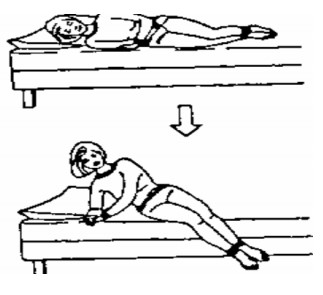Exercises and advice following Gynae Surgery
Please note, this page is printable by selecting the normal print options on your computer.
These exercises and techniques are to help you recover after your operation. If you are given this leaflet before your surgery, practice the exercises so that you are familiar with them.
First Day
Breathing Exercises, in sitting or lying
Bend your knees up a little if you are lying down. Take a deep breath in through your nose, hold for 2 seconds, then sigh out. Be aware of your lower ribs expanding as you breathe in. Repeat this 3 – 4 times. You may produce phlegm which needs clearing, particularly if you smoke. Hold your stitches/tummy with your hands or a rolled up towel, take a deep breath, then ‘huff’ – a hard, forceful breath out. Follow this with a cough. You will not harm your stitches by coughing, and discomfort is reduced if you support your stitches.
Foot Exercises
While you are not walking about, it is important to maintain blood flow in your legs to prevent a clot forming. Move your feet up and down from the ankle briskly for 30 seconds every hour.
Turning over and getting out of bed
Before moving, bend your knees up and draw in the lower part of your tummy a small amount to ‘brace’ it. Reach your arm over in the direction you want to go, at the same time roll your knees over.

To get out of bed, drop your legs over the side and push yourself up in to sitting.
Standing up – put your hands on the side of the bed, draw in your lower tummy muscles, lean forward and push yourself up into standing. Remember to ‘stand tall’ when you walk.
Going to the toilet
You may have a catheter at first to drain your bladder. Once it is removed, don’t leave it longer than 3 hours before you try to pass urine – it is important that your bladder doesn’t overfill. Take your time to make sure that your bladder is completely empty. You should ensure that you sit on the toilet seat, as hovering above may not completely empty your bladder. When you need to empty your bowels, you may find it more comfortable, if you have had vaginal surgery, to support the area just in front of the back passage with a wad of toilet paper or a sanitary towel.
Some women experience constipation after an operation which may be due to medication for pain relief. It is important to sit comfortably with your feet supported on a stool, let your tummy relax and then lean forward. You may require some laxatives in the short term; you can discuss this with your doctor. It is important that you don’t strain when you empty your bladder or bowels.
Pelvic floor exercises
You can begin these exercises as soon as your catheter has been removed. The pelvic floor is a hammock-like group of muscles at the base of the pelvis. If these muscles are weak, they are less likely to support your surgery, bladder and/or bowel; therefore, you may be vulnerable to problems such as pelvic organ prolapse after your operation.
• Sit in an upright position.
• If you have had vaginal surgery, start gently.
• Imagine that you are trying to stop yourself passing urine and ‘wind’, draw the area upwards and forwards from bowel to bladder – then let go.
• Start this ‘squeezing and lifting’ movement gently at first. ‘Squeeze and lift’ and try to hold for a few seconds (breathe normally –don’t hold your breath and ensure your buttocks and thighs are relaxed!) This is a ‘slow hold’.
• Rest for a moment, and then repeat 4 times if you can.
• Now try squeezing the pelvic floor muscles quickly 5 times. This helps your muscles react quickly when you cough or sneeze to prevent leakage and protects your surgery.
Try 5 ‘slow hold’ squeezes, followed by 5 ‘quick’ squeezes at least 4 times per day. As your muscles get stronger, try holding the ‘slow’ holds for longer. Do not try to stop and start your urine flow mid-stream. This can interfere with normal bladder function.
Advice and exercises after surgery
Support the lower part of your tummy with your hand. ‘Squeeze and lift’ the pelvic floor and at the same time, gently draw in the lower part of your tummy a small amount. Hold for 3 seconds while you breathe out. Relax, and then repeat 5 times. Bracing these muscles as you change position or get up from the chair or bed will help to make these movements more comfortable.
Household tasks, exercise, lifting and returning to work
• Immediately after your operation you should try to avoid prolonged standing and heavy lifting (anything over 2.5kgs / 5lbs or needing two hands to lift.)
• When you are comfortable it is encouraged to start walking for exercise. Begin with 5-10 minutes at a moderate pace, you should not experience pain. Remember that hills, slopes and carrying a bag will make this harder.
• Light exercise (stretching/low impact) can be started from 3-6 weeks with advice.
• More strenuous exercise can start 6-8 weeks after your operation. A gradual return should be encouraged with increasing distance and time gradually. You may want to wait for three months or longer before starting more physically active/high impact sports. Some exercises that require ‘heavy straining’ should be avoided for life following major gynaecological operations.
• Going home
• You will need time to rest and recover at home, do not rush into returning to exercise and normal life, this may lead to straining your wound.
• Avoid driving until 3-4 weeks post-surgery or 6 weeks if you have had a repair.
• Return to work will vary depending on your job role and surgery type. Usually this varies between 3-8 weeks. You can ask your employer for a return to work assessment or liaise with your GP or Women’s Health Physiotherapist for advice on how to manage this.
• To help remind you to do your pelvic floor exercises, download the NHS approved ‘Squeezy’ App which is available on all smart phones. It also has a visual cue which can help you focus whilst engaging the right muscles.
